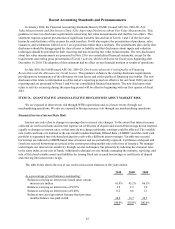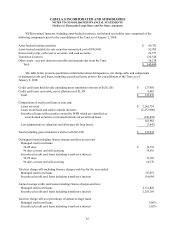Cabela's 2010 Annual Report Download - page 83
Download and view the complete annual report
Please find page 83 of the 2010 Cabela's annual report below. You can navigate through the pages in the report by either clicking on the pages listed below, or by using the keyword search tool below to find specific information within the annual report.73
CABELA’S INCORPORATED AND SUBSIDIARIES
NOTES TO CONSOLIDATED FINANCIAL STATEMENTS
(Dollars in Thousands Except Share and Per Share Amounts)
Allowance for Loan Losses – The allowance for loan losses represents management’s estimate of probable
losses inherent in the credit card loan portfolio. The allowance for loan losses is established through a charge
to the provision for loan losses and is regularly evaluated by management for adequacy. Loans on a payment
plan or non-accrual are segmented from the rest of the credit card loan portfolio into a restructured credit card
loan segment before establishing an allowance for loan losses as these loans have a higher probability of loss.
Management estimates losses inherent the credit card loans segment and restructured credit card loans segment
based on a model which tracks historical loss experience on delinquent accounts and charge-offs, net of estimated
recoveries. WFB uses a migration analysis that estimates the likelihood that a credit card loan will progress
through the various stages of delinquency and to charge-off. The migration analysis estimates the gross amount
of principal that will be charged off over of the next 12 months, net of recoveries. This estimate is used to derive
an estimated allowance. In addition to these methods of measurement, management also considers other factors
such as general economic and business conditions affecting key lending areas, credit concentration, changes in
origination and portfolio management, and credit quality trends. Since the evaluation of the inherent loss with
respect to these factors is subject to a high degree of uncertainty, the measurement of the overall allowance is
subject to estimation risk, and the amount of actual losses can vary significantly from the estimated amounts.
Credit card loans that have been modified through a fixed payment plan or placed on non-accrual are
considered impaired and are collectively evaluated for impairment. WFB charges off credit card loans and
restructured credit card loans on a daily basis after an account becomes at a minimum 130 days contractually
delinquent. Accounts relating to cardholder bankruptcies, cardholder deaths, and fraudulent transactions are
charged off earlier. WFB recognizes charged-off cardholder fees and accrued interest receivable in interest and fee
income that is included in Financial Services revenue.
Securitization of Credit Card Loans – Prior to the consolidation of the Trust on January 3, 2010, WFB sold
the majority of its credit card loans to a securitization trust and recognized related gains or losses as a component
of securitization income in Financial Services revenue. WFB retains a minimum 20 day average of 5% of the
interests in the securitization trust, which was known as a “transferor interest” in the securitized loans, and ranks
equal with the investor notes. Credit card loans classified as held for sale, which included WFB’s transferor’s
interest in securitized credit card loans, were carried at the lower of cost or market. Net unrealized losses, if any,
were recognized in income through a valuation allowance. Although WFB continued to service the underlying
credit card accounts and maintained the customer relationships, these securitization transactions were treated as
sales and the securitized loans were not included in the Company’s consolidated balance sheet. Gains or losses
were recognized at the time of sale, and depended in part on the carrying amount assigned to the credit card loans
sold, which was allocated between the assets sold and retained interest based on their relative fair values at the date
of transfer. WFB recognized a loss on sales totaling $4,157 for 2009 and a gain on sales totaling $15,657 for 2008.
WFB retained certain interests in securitized loans, including a transferor’s interest, servicing rights,
interest-only strips, cash reserve accounts, and in some cases cash accounts. WFB classified the interest-only
strips and cash reserve accounts as retained interests in securitized loans. A servicing asset or liability was not
recognized as WFB received adequate compensation relative to current market servicing rates.
In addition, WFB owned asset-backed securities from its securitizations, which in some cases were
subordinated to other notes issued as retained interests in securitized loans. The asset-backed securities were
classified as trading securities or available-for-sale securities. Asset-backed trading securities fluctuated daily
based on the short-term operational needs of WFB. Advances and pay downs on the trading securities were at
par value. Therefore, the par value of the asset-backed trading securities approximated fair value. Asset-backed
available-for-sale securities were carried at fair value with changes reflected in accumulated other comprehensive
income. For asset-backed available-for-sale securities, WFB estimated fair value using discounted cash flow
projection estimates based upon management’s evaluation of contractual principal and interest cash flows.
























